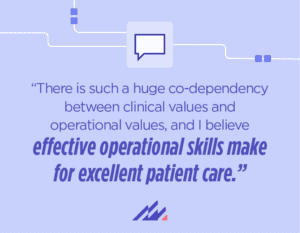Article
A COO’s view: The importance of integrating EPR and patient flow information
Since the launch of the NHS elective recovery plan, which sets out a vision for how the NHS will recover elective care, more and more trusts are integrating their EPRs and advanced data systems to improve patient flow within hospitals and between care providers.
Spending the first 25 years of my career as a frontline nurse, I’ve seen first-hand how technology can help clinical staff manage and improve patient flow. I’ve also witnessed the importance of operational management working hand-in-hand with clinical teams to ensure digital systems are implemented in a way that has the most positive impact on patient care, clinical pathways and operational processes.
Throughout my career, and particularly during my time as a senior nurse, I learned how the values of nursing could influence good operational processes and management, and vice versa. There is such a huge co-dependency between clinical values and operational values, and I believe effective operational skills make for excellent patient care.
Office of the COO
It’s the responsibility of a COO to ensure that a safe, effective and appropriate infrastructure is in place across the trust. In my operational leadership roles, one of my main priorities was always effective patient flow across the hospital. This relies on clinicians having access to information, the ability to record and analyse real-time data and the integration of clinical systems to enable decision-making.
During my time in the NHS, I have overseen the introduction of new patient administration systems (PAS) and electronic patient record systems (EPRs), including many integration projects. As a COO, it was important to me to be the SRO for the programmes introducing the deployment of new critical digital systems, ensuring I had accountability to bring together a team including key leaders and change-makers to plan the needs of those using the system every day, and collect their feedback on what worked and what didn’t.
The role of a COO requires the ability to effectively communicate, influence and direct various teams across the hospital to achieve set goals. This is especially true when considering the balance with regards to emergency and elective patient flow capacities.
Driving digital maturity
EPRs have transformed the way data is stored, managed and presented in those trusts that have successfully implemented them. As part of the next stage of digital transformation, we are seeing many of the more digitally mature trusts move towards integrated EPR and patient flow systems that combine the clinical data stored within patient records with bed management and operational information to help optimise capacity planning and discharge forecasting.
By combining EPR and patient flow information, trusts can automate complex processes and improve patient throughput, helping increase the overall efficiency of the hospital.
 Benefits of EPRs and patient flow systems
Benefits of EPRs and patient flow systems
The real benefit from EPRs and patient flow systems comes when they are used to support the whole care system, including ambulance trusts, community health provision and social care resources. My hope is that the new additional funding that has been made available to reduce the pressure caused by delayed discharges is spent wisely to help care systems improve patient flow between care settings, not just within the acute hospital walls.
As for those trusts and care systems with limited resources, I believe it’s important to get current data sets working as hard as they possibly can. To help track daily demands, support capacity projection and accurately calculate requirements through real-time EPR information, making sure that information is accessible to fully support patient flow.
Technology alone doesn’t create the conditions for patient flow to work effectively but it makes it possible to manage patient journeys with more efficiency, visibility and predictability. Every patient that comes through the hospital has to be managed safely and correctly to ensure they are able to move forward in their care—efficiently and safely. By combining clinical data with operational information such as bed requests, portering and transport helps ensure patients are moved through the care pathway more efficiently, creating better outcomes for the patient themselves, clinicians and the NHS.
It’s invaluable to clinical and operational staff to have a system that enables them to measure demand and capacity across every single service, while being able to monitor patients in and out, how many beds are needed and which patients need to be discharged.
I believe having COOs working closely with clinicians on a day-to-day basis, for planning and managing services, provides a level of confidence in leadership, and helps build relationships that are essential to streamlining technology and processes.
Overall, the role of a COO is a big responsibility. And arguably, one of the most important projects a trust can undertake on its digital maturity journey is deploying a patient flow solution and integrating with an EPR. To help make such a project a success, COOs must work in tandem with clinical leaders, clinical information officers and chief clinical information officers. As integrated care boards mature, I expect COOs to work across multiple care settings—acute, community and social care—which makes them ideally placed to drive patient flow solutions that will help improve joined-up care and leadership across a region.
For trusts considering implementing a patient flow system, I advise finding the right people with the enthusiasm, vision and tenacity to drive through digital transformation and translate this into patient care, and employ them as digital champions. After all, the benefits of improved patient flow can only be realised with full commitment to digital transformation.













